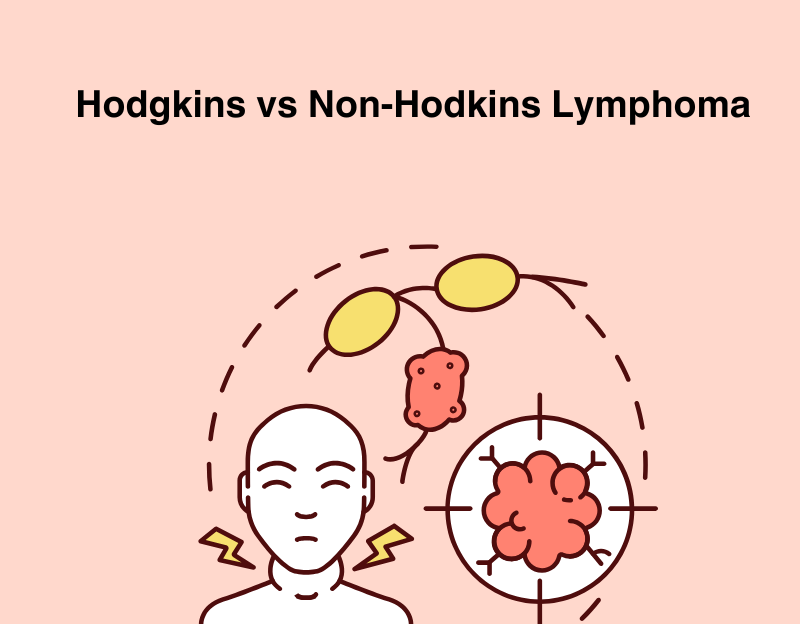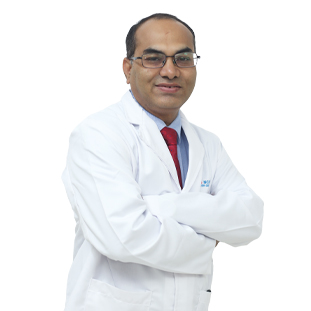
25 Apr, 2025

25 Apr, 2025

This article is medically reviewed by Dr. Nishad Dhakate, Consultant - Hematology & BMT, HCG Cancer Centre, Nagpur
Hodgkin’s lymphoma is a cancerous condition that develops in the lymphatic system, which is a part of the immune system. The disease is characterized by abnormal lymphocytic growth. Lymphocytes are types of white blood cells.
The organs affected by Hodgkin's lymphoma are the lymph nodes, thymus, spleen, bone marrow, and tonsils. The presence of Reed-Sternberg cells is the most distinguishing feature of Hodgkin's lymphoma.
Patients with this disease experience various symptoms, such as night sweats, fever, swollen lymph nodes, and unexplained weight loss. Hodgkin’s lymphoma usually affects the younger adults. The disease often responds to various treatments, such as radiation therapy, immunotherapy, chemotherapy, or stem cell transplants, and has a high cure rate. Early diagnosis improves outcomes.
Non-Hodgkin’s lymphoma also develops in the lymphatic system. However, Reed-Sternberg cells are absent in non-Hodgkin’s lymphoma. The disease may develop in the B-lymphocytes or T-lymphocytes. Non-Hodgkin’s lymphoma may grow slowly or aggressively.
Symptoms are similar to Hodgkin's lymphoma and include swollen lymph nodes in the groin, neck, or armpits, persistent fatigue, chest pain, abdominal pain, fever, unexplained weight loss, and night sweats.
The disease may occur at any age. However, older adults are more commonly affected. The treatment options are targeted therapy, chemotherapy, immunotherapy, monoclonal antibodies, and radiation therapy.
The prognosis of the disease depends upon the stage and type of non-Hodgkin’s lymphoma, treatment response, and overall health of the patients. Early detection is crucial for better outcomes in non-Hodgkin’s lymphoma patients.
Some of the differences between Hodgkin's lymphoma and non-Hodgkin's lymphoma are:
Hodgkin's lymphoma cancer is often characterized by swollen, painless lymph nodes in the armpits, neck, and groin. The disease usually spreads in a predictable pattern from one lymph node to another.
Non-Hodgkin's lymphoma can affect the nodes in all parts of the body. Its spread is relatively more unpredictable compared with Hodgkin's lymphoma. In patients with non-Hodgkin's lymphoma, multiple nodes may be affected.
Non-Hodgkin’s lymphoma can also involve other organs like the lung, liver, bones, kidneys, brain, and stomach.
Hodgkin's lymphoma is characterized by Reed-Sternberg cells, which are absent in non-Hodgkin’s lymphoma. The cellular features are more varied in non-Hodgkin’s lymphoma than in Hodgkin’s lymphoma.
Some of the non-Hodgkin’s lymphoma symptoms and Hodgkin’s lymphoma symptoms are similar, such as swollen lymph nodes, night sweats, unexplained weight loss, persistent cough, and fatigue.
However, Hodgkin's lymphoma symptoms may also include itching and higher sensitivity to alcohol. Non-Hodgkin's lymphoma cancer symptoms also include chest pain, abdominal pain, difficulty breathing, and leg swelling.
Biopsy and imaging techniques are important diagnostic tools for diagnosing and staging both non-Hodgkin's and Hodgkin's lymphoma.
The lymph node biopsy assists in differentiating both lymphomas by determining the presence of Reed-Sternberg cells. Other imaging techniques for both lymphomas include PET scans, CT scans, and X-rays for diagnosing and staging the disease.
Patients with non-Hodgkin’s lymphoma may also undergo bone marrow biopsy to detect a more aggressive form.
Blood tests and biomarkers are not the confirmatory tests for diagnosing non-Hodgkin’s lymphoma and Hodgkin’s lymphoma. However, they play a crucial supportive role.
Blood tests for Hodgkin's lymphoma may show anemia, elevated inflammatory markers, and abnormal white blood cells. Abnormal lactate dehydrogenase levels suggest higher disease activity. Patients with Hodgkin's lymphoma sometimes have CD30 as a biomarker.
Abnormal levels of lactate dehydrogenase in non-Hodgkin's lymphoma indicate rapid cell turnover. The patients may have specific biomarkers, such as CD20 in B-cell lymphomas.
Hodgkin's lymphoma is limited to a single lymph node or lymphoid organ at this stage.
At stage II, the disease spreads to ≥2 lymph node areas on the same side of the diaphragm. The disease may also spread to an organ near the affected lymph node.
At stage III, the disease spreads to both sides of the diaphragm. It may also affect the lymph nodes above the diaphragm and the spleen.
It is the advanced stage of the disease. The disease spreads to ≥1 organ outside the lymph system, such as bone marrow, liver, or lungs.
The lymphoma is localized and is limited to only a single lymph node.
The lymphoma may be present in ≥2 lymph nodes on the same side of the diaphragm.
At stage III of the non-Hodgkin's lymphoma, there is extensive lymph node involvement. The affected lymph nodes may be present on both sides of the diaphragm. Further, the lymph nodes above the diaphragm and the spleen are simultaneously affected.
At stage IV, non-Hodgkin’s lymphoma spreads widely into ≥1 organ outside the lymphatic system, such as the liver, bone marrow, or lungs.
The Hodgkin's and non-Hodgkin's lymphoma treatments differ based on the type, stage, and specific disease characteristics.
If Hodgkin’s lymphoma is non-responsive to conventional treatment, it may require other, more innovative treatment options such as immunotherapy or targeted therapy. Stem cell transplant may be recommended in patients with recurrent Hodgkin’s lymphoma.
Localized cases of non-Hodgkin’s lymphoma are managed through radiation therapy. Stem cell transplant is an option for aggressive and relapsed non-Hodgkin’s lymphoma, while relapsed or refractory cases can be managed through CAR-T cell therapy.
Hodgkin's lymphoma has a higher survival rate than non-Hodgkin's lymphoma. Studies have reported long-term remission in most patients after treatment. The risk of relapse varies with several factors, including the stage of the disease. The disease diagnosed at an early stage has a lower relapse risk.
The presence of various subtypes in non-Hodgkin’s lymphoma results in variable outcomes. Higher relapse rates are reported in patients with aggressive non-Hodgkin’s lymphoma. Survival rates vary and depend on the subtype, stage of the disease, and treatment response. The survival rate has improved with advanced treatment options.
Patients with lymphoma have an emotional, physical, and financial impact. They may experience various symptoms, such as weight loss, fatigue, and swollen lymph nodes, in varying severity. The treatment-associated side effects, such as nausea, compromised immunity, and hair loss, also reduce the quality of life.
It is important to visit the oncologists at the scheduled visit to evaluate the treatment response. Follow-up monitoring is important to identify relapses once the treatment is over and the disease is in remission.
Support from family, friends, and a support group is important for managing stress. Lifestyle adjustments, such as exercise, a balanced diet, and stress management, improve overall quality of life.
It is important to support patients with lymphoma to effectively manage the disease and improve their quality of life. These patients should have access to high-quality medical care. As the disease has an emotional effect, these patients should be offered psychological support to cope with stress and other emotional challenges.
Such patients should receive assistance with transportation, insurance, and daily living needs to minimize their financial burden. They should also receive appropriate and detailed information about the disease to allow them to make informed decisions. Family and friends should encourage the patients and offer emotional support.
As a leading hospital in cancer treatment in India, HCG Cancer Centre offers advanced diagnostic and treatment options for patients diagnosed with different types of cancer, including non-Hodgkin's lymphoma and Hodgkin’s lymphoma. The disease is diagnosed through imaging techniques such as CT scans, PET scans, and MRI. Biopsies are recommended for a conclusive diagnosis. HCG also provides genetic testing solutions, which help specialists differentiate between Hodgkin's and non-Hodgkin's lymphoma.
The hospital offers conservative treatments, such as chemotherapy and radiation therapy, and advanced treatments, such as targeted therapy, CAR T-cell therapy, and stem cell transplant, to patients diagnosed with lymphoma.
Hodgkin's lymphoma and non-Hodgkin's lymphoma are cancers of the lymphatic system, but they differ in several ways. Hodgkin's is marked by Reed-Sternberg cells and generally follows a predictable spread pattern, while non-Hodgkin's has more diverse cell types and unpredictable spread.
The symptoms of Hodgkin’s lymphoma cancer and non-Hodgkin’s lymphoma cancer are swollen lymph nodes, night sweats, and weight loss, but treatments vary based on type, stage, and aggressiveness. Hodgkin's typically has a higher cure rate, while non-Hodgkin's outcomes depend on the subtype. Early diagnosis improves the prognosis for both types.

Dr. Nishad Dhakate
Consultant - Hematology and BMT
MBBS, MD (General Medicine), DM (Haematology)
Dr. Nishad Dhakate is a highly experienced and certified hematology and BMT specialist, and he specializes in autologous and allogeneic blood and bone marrow transplants, leukemia, lymphoma, and myeloma. He is available for consultation at HCG Cancer Centre, a leading cancer hospital in Nagpur. He is well versed in managing hematological disorders, inherited and acquired red, white, and platelet disorders, as well as immunodeficiency disorders. His approach to treatment is comprehensive and tailored to each patient's individual needs. He is committed to providing the best possible care to his patients and strives to stay up to date with the latest innovations in the field of medical oncology.